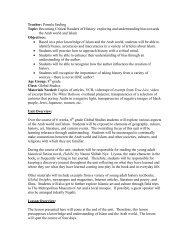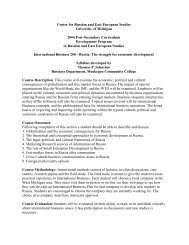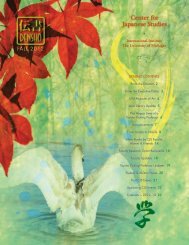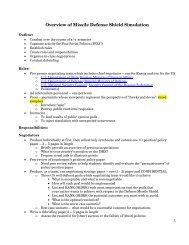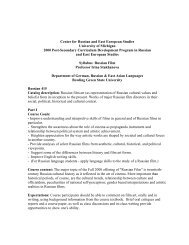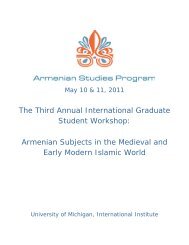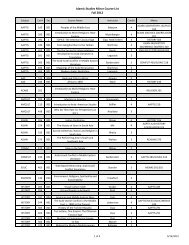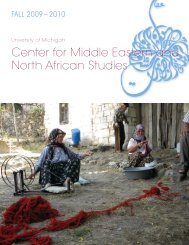The New Korean Wave in the Creative Industry - International ...
The New Korean Wave in the Creative Industry - International ...
The New Korean Wave in the Creative Industry - International ...
Create successful ePaper yourself
Turn your PDF publications into a flip-book with our unique Google optimized e-Paper software.
II JOURNAL Fall 2012 University of Michigan 3<br />
<strong>The</strong> <strong>New</strong> <strong>Korean</strong> <strong>Wave</strong> <strong>in</strong> <strong>the</strong> <strong>Creative</strong> <strong>Industry</strong><br />
HALLYU<br />
by Dal Yong J<strong>in</strong><br />
S<strong>in</strong>ce <strong>the</strong> mid-1990s, <strong>the</strong><br />
<strong>Korean</strong> <strong>Wave</strong> has become<br />
a global sensation.<br />
Several Asian countries, <strong>in</strong>clud<strong>in</strong>g Japan,<br />
Ch<strong>in</strong>a, and Vietnam have absorbed <strong>Korean</strong><br />
popular culture, and several <strong>Korean</strong> cultural<br />
genres, <strong>in</strong>clud<strong>in</strong>g television programs and<br />
films have become major cultural activities<br />
<strong>in</strong> <strong>the</strong>se countries. Korea has recently<br />
started to penetrate European and North<br />
American countries with popular music<br />
(K-Pop) and onl<strong>in</strong>e gam<strong>in</strong>g. <strong>The</strong> <strong>Korean</strong><br />
<strong>Wave</strong> has been unique because it <strong>in</strong>dicates<br />
<strong>the</strong> unusual growth of local creative<br />
<strong>in</strong>dustries <strong>in</strong> <strong>the</strong> midst of neoliberal<br />
globalization. Once peripheral and small,<br />
<strong>the</strong> <strong>Korean</strong> creative <strong>in</strong>dustries have<br />
unexpectedly developed <strong>the</strong>ir own local<br />
cultural products and services, and Korea’s<br />
creative <strong>in</strong>dustries have been among <strong>the</strong><br />
most successful contributors to <strong>the</strong> national<br />
economy.<br />
<strong>The</strong> <strong>Korean</strong> <strong>Wave</strong> has especially<br />
experienced a significant change with<br />
<strong>the</strong> development of digital technologies<br />
and social media, such as YouTube, social<br />
network sites (SNSs), and smartphones <strong>in</strong><br />
<strong>the</strong> 21st century. <strong>The</strong>se digital technologies,<br />
as new driv<strong>in</strong>g eng<strong>in</strong>es of <strong>the</strong> <strong>Korean</strong> <strong>Wave</strong>,<br />
have <strong>in</strong>itiated and supported <strong>the</strong> popularity<br />
of local culture <strong>in</strong>many countries. Unlike<br />
Hallyu 1.0, emphasiz<strong>in</strong>g <strong>the</strong> export of local<br />
cultural goods to East Asia between <strong>the</strong><br />
late 1990s and 2007, <strong>the</strong> growth of social<br />
media has uniquely <strong>in</strong>fluenced <strong>Korean</strong> creative<br />
<strong>in</strong>dustries, because a few media outlets, such<br />
as YouTube and SNSs, have become significant<br />
parts of <strong>the</strong> new <strong>Korean</strong> <strong>Wave</strong> (Hallyu 2.0). In<br />
fact, onl<strong>in</strong>e gam<strong>in</strong>g and K-Pop have become<br />
<strong>the</strong> two most significant cultural genres <strong>in</strong> <strong>the</strong><br />
<strong>Korean</strong> creative <strong>in</strong>dustries and have <strong>in</strong>itiated<br />
<strong>the</strong> growth of Hallyu 2.0 s<strong>in</strong>ce late 2007,<br />
because K-Pop fans and onl<strong>in</strong>e game users<br />
<strong>The</strong> <strong>Korean</strong> wave (Hallyu) refers<br />
to <strong>the</strong> significant <strong>in</strong>crease <strong>in</strong><br />
<strong>the</strong> popularity of South <strong>Korean</strong><br />
enterta<strong>in</strong>ment and culture<br />
start<strong>in</strong>g <strong>in</strong> <strong>the</strong> 1990s, <strong>in</strong> Asia,<br />
and more recently <strong>in</strong> o<strong>the</strong>r<br />
parts of <strong>the</strong> world.<br />
Girls’ Generation is a popular n<strong>in</strong>emember<br />
South <strong>Korean</strong> girl group.<br />
Formed <strong>in</strong> 2007, <strong>the</strong>y have sold more<br />
than 100,000 copies for each of <strong>the</strong>ir six<br />
<strong>Korean</strong> releases.
4 II JOURNAL Fall 2012 University of Michigan<br />
heavily access <strong>the</strong>se social media to enjoy<br />
local popular culture. Hallyu 2.0 is <strong>the</strong><br />
comb<strong>in</strong>ation of social media, <strong>the</strong>ir practices,<br />
and <strong>the</strong> uses and affordances <strong>the</strong>y provide,<br />
and this new stage has been made possible<br />
because Korea has advanced its digital<br />
technologies. By mapp<strong>in</strong>g out <strong>the</strong> growth<br />
of Hallyu 2.0, we discuss <strong>the</strong> role of social<br />
media-driven consumption and cultural<br />
production flows <strong>in</strong> Asia and across <strong>the</strong><br />
globe <strong>in</strong> <strong>the</strong> context of creative <strong>in</strong>dustries.<br />
From Cultural Industries to <strong>Creative</strong><br />
Industries<br />
<strong>The</strong> development of <strong>the</strong> Hallyu phenomenon<br />
has been closely related to <strong>the</strong> cultural<br />
policies <strong>in</strong> <strong>the</strong> realm of cultural/creative<br />
<strong>in</strong>dustries, because <strong>the</strong> major characteristics<br />
and genres have changed based on<br />
different cultural policies. <strong>The</strong> notion of <strong>the</strong><br />
cultural <strong>in</strong>dustries orig<strong>in</strong>ally started <strong>in</strong> <strong>the</strong><br />
19th century when <strong>the</strong> commercialization<br />
of cultural production began <strong>in</strong> societies.<br />
<strong>The</strong> cultural <strong>in</strong>dustries were later very much<br />
bound up with <strong>the</strong> rise of mass culture—a<br />
phenomenon that troubled many 20thcentury<br />
<strong>in</strong>tellectuals. React<strong>in</strong>g aga<strong>in</strong>st what<br />
<strong>the</strong>y saw as <strong>the</strong> mislead<strong>in</strong>gly democratic<br />
connotations of <strong>the</strong> term mass culture,<br />
<strong>The</strong>odor Adorno and Max Horkheimer<br />
developed <strong>the</strong> idea of <strong>the</strong> culture <strong>in</strong>dustries<br />
as part of <strong>the</strong>ir critique of <strong>the</strong> false legacies<br />
of <strong>the</strong> Enlightenment, where <strong>the</strong> term was<br />
<strong>in</strong>tended to draw critical attention to <strong>the</strong><br />
commodification of art. In <strong>the</strong>ir view, culture<br />
had almost entirely lost this capacity to act<br />
as utopian critique because it had become<br />
commodified, a th<strong>in</strong>g to be bought and sold.<br />
<strong>The</strong> cultural <strong>in</strong>dustries have moved closer<br />
to <strong>the</strong> center of <strong>the</strong> economic action<br />
<strong>in</strong> many countries. Cultural <strong>in</strong>dustry<br />
companies can no longer be seen as<br />
secondary to <strong>the</strong> real economy. As <strong>the</strong><br />
United Nations Educational, Scientific, and<br />
Cultural Organization (UNESCO) def<strong>in</strong>ed,<br />
a cultural <strong>in</strong>dustry is held to exist when<br />
cultural goods and services are produced,<br />
reproduced, stored or distributed on<br />
<strong>in</strong>dustrial and commercial l<strong>in</strong>es, that is<br />
to say on a large scale and <strong>in</strong> accordance<br />
with a strategy based on economic<br />
considerations ra<strong>the</strong>r than any concerns<br />
for cultural development. S<strong>in</strong>ce policies<br />
towards <strong>the</strong> cultural <strong>in</strong>dustries can no<br />
longer be separated from <strong>in</strong>formation and<br />
communication technologies (ICTs) and<br />
<strong>the</strong> wider <strong>in</strong>formation society with<strong>in</strong> which<br />
that policy is formulated, <strong>in</strong>cluded <strong>in</strong> <strong>the</strong><br />
cultural <strong>in</strong>dustries are <strong>the</strong> press, film, radio,<br />
television, record<strong>in</strong>g, advertis<strong>in</strong>g, sports,<br />
and most recently, <strong>the</strong> many components<br />
that now make up <strong>the</strong> <strong>in</strong>formation <strong>in</strong>dustry.<br />
S<strong>in</strong>ce <strong>the</strong> mid-1990s, <strong>the</strong> concept of<br />
cultural <strong>in</strong>dustries has shifted with <strong>the</strong><br />
Onl<strong>in</strong>e games and K-pop have become <strong>the</strong> two most<br />
significant cultural genres <strong>in</strong> <strong>the</strong> Hallyu 2.0 era. Unlike<br />
television programs and films, <strong>the</strong>se cultural genres<br />
become a global, not regional, sensation.
II JOURNAL Fall 2012 University of Michigan 5<br />
My Lovely Sam-Soon (Nae ireumeun Kim Sam-soon) is a popular<br />
<strong>Korean</strong> television drama that began air<strong>in</strong>g <strong>in</strong> 2005 and features <strong>the</strong><br />
misadventures and romantic entanglements of Kim Sam-Soon, a<br />
passionate, stubborn, klutzy, and almost thirty-year-old pastry chef.<br />
growth of digital technologies and<br />
<strong>in</strong>tellectual property (IP) rights toward<br />
creative <strong>in</strong>dustries. In 1994, Australia<br />
sought to chart a cultural policy comb<strong>in</strong><strong>in</strong>g<br />
<strong>the</strong> arts with new communications<br />
technologies, and <strong>the</strong> notion of cultural<br />
<strong>in</strong>dustry has been transposed to <strong>the</strong><br />
creative <strong>in</strong>dustries. <strong>The</strong> notion of creative<br />
<strong>in</strong>dustries subsequently ga<strong>in</strong>ed much wider<br />
acceptance follow<strong>in</strong>g its adoption by <strong>the</strong><br />
U.K government <strong>in</strong> 1997, which def<strong>in</strong>ed<br />
<strong>the</strong> creative <strong>in</strong>dustries as those activities<br />
orig<strong>in</strong>at<strong>in</strong>g <strong>in</strong> <strong>in</strong>dividual creativity, skill,<br />
and talent and which have a potential<br />
for wealth and job creation through <strong>the</strong><br />
generation and exploitation of IP. Unlike <strong>the</strong><br />
term cultural <strong>in</strong>dustry, which has its orig<strong>in</strong><br />
<strong>in</strong> <strong>the</strong> ideological critique of art and culture<br />
under <strong>in</strong>dustrial capitalism associations with<br />
<strong>the</strong> neo-Marxist <strong>the</strong>ories, creative <strong>in</strong>dustries<br />
have developed <strong>in</strong> tandem with <strong>the</strong> growth<br />
of digital technologies and convergence.<br />
television dramas, What<br />
is Love All About (1997)<br />
and Stars <strong>in</strong> My Heart<br />
(1997), becom<strong>in</strong>g popular<br />
<strong>in</strong> East Asia. Korea sold<br />
ano<strong>the</strong>r popular program,<br />
Stairways to Heaven (a<br />
tragic story of a young<br />
couple who fall <strong>in</strong> love<br />
and get married) to<br />
Japan <strong>in</strong> 2004. Between<br />
2004 and 2006, two o<strong>the</strong>r famous<br />
dramas, W<strong>in</strong>ter Sonata (a touch<strong>in</strong>g love<br />
story about a woman and her boyfriend<br />
suffer<strong>in</strong>g from amnesia), and Daejanggeum<br />
(<strong>the</strong> popular period drama series) also<br />
became huge hits <strong>in</strong> Japan and Hong Kong.<br />
Due to <strong>the</strong> grow<strong>in</strong>g popularity of <strong>the</strong>se<br />
programs, <strong>the</strong> total amount of television<br />
program exports <strong>in</strong>creased 27.4 times<br />
between 1995 and 2007, from $5.5 million<br />
nascent <strong>Korean</strong> cultural products<br />
boom <strong>in</strong> Asia has been fur<strong>the</strong>r bolstered by<br />
<strong>the</strong> advance of domestic films. Start<strong>in</strong>g <strong>in</strong><br />
<strong>the</strong> late 1990s, Korea began to export films<br />
to East Asia (such as Silmido and Tae Guk<br />
Gi), and it has extended its export of<br />
domestic films beyond Asia <strong>in</strong> recent years.<br />
As with Japanese filmmakers, Hollywood<br />
has remade several <strong>Korean</strong> domestic films,<br />
<strong>in</strong>clud<strong>in</strong>g Siworae (2000) (a fantasy<br />
In <strong>the</strong> 21st century, <strong>the</strong> <strong>Korean</strong> government<br />
has emphasized <strong>the</strong> importance of cultural<br />
content for national economy. With some<br />
tweaks, <strong>the</strong> Lee Myung-pak (2008-2013)<br />
government has shifted its focus to<br />
(commodified) creativity <strong>in</strong> conjunction with<br />
content, and policymakers have used <strong>the</strong><br />
term ‘creative contents <strong>in</strong>dustry’ <strong>in</strong>stead<br />
of creative <strong>in</strong>dustry s<strong>in</strong>ce 2009. By us<strong>in</strong>g<br />
<strong>the</strong> U.K.’s creative <strong>in</strong>dustry as a model, <strong>the</strong><br />
Lee government has advanced <strong>the</strong> content<br />
<strong>in</strong>dustry as a new driv<strong>in</strong>g eng<strong>in</strong>e for <strong>the</strong><br />
national economy.<br />
Hallyu 1.0: Cultural Flows to Asia<br />
<strong>The</strong> <strong>Korean</strong> cultural firms had developed<br />
many of <strong>the</strong>ir cultural products and<br />
expanded <strong>the</strong> exportation of <strong>the</strong>se products<br />
to ma<strong>in</strong>ly East and Sou<strong>the</strong>ast Asia <strong>in</strong> <strong>the</strong><br />
Hallyu 1.0 era. <strong>The</strong> <strong>Korean</strong> cultural products<br />
first penetrated <strong>the</strong> Ch<strong>in</strong>ese market with<br />
<strong>in</strong> 1995 to $150.9 million <strong>in</strong> 2007. <strong>The</strong><br />
majority of <strong>Korean</strong> cultural products were<br />
consumed <strong>in</strong> Asia, especially Japan (57.4%),<br />
Taiwan (18.4%), and Ch<strong>in</strong>a and Hong Kong<br />
(8.9%). Among television programs<br />
exported, dramas accounted for <strong>the</strong> largest<br />
share (87.8%) followed by enterta<strong>in</strong>ment<br />
(8.4%), while animation consisted of only<br />
0.6% <strong>in</strong> 2007. <strong>The</strong> proportion of dramas<br />
exported had rapidly <strong>in</strong>creased thanks, <strong>in</strong><br />
large part, to a period drama series. <strong>The</strong><br />
. . . K-Pop has been a driver of Hallyu 2.0<br />
as Korea exported $80.9 million worth<br />
of music <strong>in</strong> 2010, a 159% <strong>in</strong>crease from<br />
2009. Fur<strong>the</strong>rmore, <strong>in</strong> 2011, <strong>the</strong> music<br />
<strong>in</strong>dustry exported $177 million, a 112%<br />
<strong>in</strong>crease from <strong>the</strong> previous year.<br />
romance remade as Lake House <strong>in</strong><br />
Hollywood <strong>in</strong> 2006); Yeogijeog<strong>in</strong> geunyeo<br />
(2001) (a romantic comedy remade as My<br />
Sassy Girl <strong>in</strong> Hollywood <strong>in</strong> 2008); and<br />
Jungdok (2002) (a spooky romantic thriller<br />
remade as Possession <strong>in</strong> Hollywood, 2008).<br />
Several TV dramas and films are projected<br />
to ga<strong>in</strong> even more success <strong>in</strong> <strong>the</strong> future, as<br />
<strong>the</strong>y f<strong>in</strong>d new audiences <strong>in</strong> o<strong>the</strong>r parts of<br />
<strong>the</strong> world. However, <strong>the</strong> <strong>Korean</strong> film<br />
<strong>in</strong>dustry has shown a sharp decl<strong>in</strong>e s<strong>in</strong>ce
6 II JOURNAL Fall 2012 University of Michigan<br />
2006 partially due to <strong>the</strong> reduction of <strong>the</strong><br />
screen quota as part of its free trade<br />
agreement (FTA) with <strong>the</strong> U.S. <strong>The</strong> export<br />
of <strong>Korean</strong> films had <strong>in</strong>creased from $7<br />
million <strong>in</strong> 2000 to $76 million <strong>in</strong> 2005;<br />
however, it fell to $13.5 million <strong>in</strong> 2010.<br />
Hallyu 2.0: <strong>The</strong> Role of Social Media<br />
<strong>in</strong> <strong>the</strong> <strong>Creative</strong> Industries<br />
S<strong>in</strong>ce late 2007, <strong>the</strong> Hallyu phenomenon<br />
has experienced a significant shift with <strong>the</strong><br />
growth of social media. Korea has made<br />
<strong>in</strong>novations <strong>in</strong> SNSs (e.g., Cyworld) and<br />
smartphones (e.g., Samsung’s Galaxy), as<br />
well as onl<strong>in</strong>e gam<strong>in</strong>g (e.g., L<strong>in</strong>eage and<br />
Aion), and <strong>the</strong>y become major parts of<br />
<strong>the</strong> <strong>Korean</strong> <strong>Wave</strong>. Western-based social<br />
media and smartphones have also taken<br />
pivotal roles <strong>in</strong> spread<strong>in</strong>g out K-Pop and<br />
o<strong>the</strong>r cultural genres, because fans <strong>in</strong> many<br />
countries enjoy K-Pop and o<strong>the</strong>r cultural<br />
products through social media, referr<strong>in</strong>g to<br />
a group of Internet-based applications that<br />
build on <strong>the</strong> ideological and technological<br />
foundations of Web 2.0, which allow <strong>the</strong><br />
creation and exchange of user-generated<br />
content.<br />
<strong>The</strong> <strong>Korean</strong> creative <strong>in</strong>dustries have<br />
<strong>in</strong>deed witnessed a few new eng<strong>in</strong>es of<br />
growth s<strong>in</strong>ce late 2007. With <strong>the</strong> rapid<br />
advancement of broadband services, onl<strong>in</strong>e<br />
gam<strong>in</strong>g has become a burgeon<strong>in</strong>g cultural<br />
sector with global revenues rival<strong>in</strong>g those<br />
of film and music. Korea exported $102<br />
million worth of games <strong>in</strong> 2000; however,<br />
<strong>in</strong> 2010, <strong>the</strong> country exported as much as<br />
$1.6 billion worth of games. Dur<strong>in</strong>g <strong>the</strong><br />
period 2000-2010, <strong>the</strong> export <strong>in</strong>creased<br />
15.7 times. <strong>The</strong> <strong>Korean</strong> onl<strong>in</strong>e game<br />
<strong>in</strong>dustry has substantially ga<strong>in</strong>ed status as<br />
an empire <strong>in</strong> <strong>the</strong> cultural sector and is one<br />
of <strong>the</strong> most significant exported cultural<br />
products of Korea.<br />
K-Pop has become <strong>the</strong> most dist<strong>in</strong>ct<br />
cultural genre <strong>in</strong> <strong>the</strong> Hallyu 2.0 era. While<br />
K-Pop was part of <strong>the</strong> early growth <strong>in</strong><br />
<strong>the</strong> <strong>Korean</strong> <strong>Wave</strong>, Korea did not make<br />
impressive popularity <strong>in</strong> <strong>the</strong> global music<br />
markets until recent years. However, K-Pop<br />
has been a driver of Hallyu 2.0 as Korea<br />
exported $80.9 million worth of music<br />
<strong>in</strong> 2010, a 159% <strong>in</strong>crease from 2009.<br />
Fur<strong>the</strong>rmore, <strong>in</strong> 2011, <strong>the</strong> music <strong>in</strong>dustry<br />
exported $177 million, a 112% <strong>in</strong>crease<br />
from <strong>the</strong> previous year. Onl<strong>in</strong>e gam<strong>in</strong>g and<br />
K-Pop have been <strong>the</strong> two most significant<br />
cultural sectors <strong>in</strong> <strong>the</strong> <strong>Korean</strong> creative<br />
<strong>in</strong>dustries.<br />
While <strong>the</strong>re are several reasons for <strong>the</strong><br />
tremendous growth of Hallyu 2.0, aga<strong>in</strong>,<br />
one of <strong>the</strong> most significant catalysts has<br />
been <strong>the</strong> rapid growth of social media,<br />
as global media fans use social media<br />
to access K-Pop and games. From usergenerated<br />
content web sites to peer-topeer<br />
networks, <strong>the</strong>se channels play a<br />
central role <strong>in</strong> global cultural circulation.<br />
With youth consumer groups as central<br />
figures, SNSs have become <strong>the</strong> fastest<br />
grow<strong>in</strong>g platforms to circulate global<br />
cultural products. This implies that <strong>the</strong><br />
cultural markets have rapidly shifted, from<br />
virtual goods-driven to access-oriented<br />
watch<strong>in</strong>g markets, because global<br />
consumers watch and play cultural genres<br />
through social media <strong>in</strong>stead of buy<strong>in</strong>g<br />
cultural goods. In <strong>the</strong> era of volatile<br />
changes <strong>in</strong> global creative <strong>in</strong>dustries<br />
driven by technological <strong>in</strong>novation and<br />
globalization dynamics, understand<strong>in</strong>g<br />
<strong>the</strong> role of social media and its impact on<br />
cultural accumulation is crucial.<br />
One of <strong>the</strong> major drivers for <strong>the</strong> growth of<br />
<strong>Korean</strong> creative <strong>in</strong>dustries and Hallyu 2.0<br />
has been <strong>the</strong> convergence of multimedia<br />
and telecommunication technologies and<br />
<strong>the</strong> <strong>in</strong>tegration of <strong>the</strong> means by which<br />
creative content is produced, distributed,<br />
and consumed <strong>in</strong> <strong>the</strong> Hallyu 2.0 era. Korea<br />
has harnessed <strong>the</strong> potential of develop<strong>in</strong>g<br />
creative content with new technologies <strong>in</strong><br />
video games, animation, and K-Pop.<br />
Intellectual Properties <strong>in</strong> <strong>the</strong><br />
Hallyu 2.0 Era<br />
Hallyu 2.0 cannot be understood without<br />
<strong>the</strong> crucial role of IP rights. <strong>The</strong> term<br />
creative <strong>in</strong>dustries was used primarily to<br />
promote <strong>the</strong> development of <strong>in</strong>dustries<br />
based on <strong>the</strong> exploitation of IP, which<br />
A screen shot from <strong>the</strong> popular<br />
<strong>Korean</strong> social network<strong>in</strong>g website<br />
Cyworld.
II JOURNAL Fall 2012 University of Michigan 7<br />
<strong>Korean</strong> rapper and songwriter PSY is<br />
well-known for his humorous videos and<br />
stage performances, and for his hit s<strong>in</strong>gle<br />
“Gangnam Style,” which is <strong>the</strong> most<br />
viewed K-pop video on YouTube with<br />
more than 583 million views. On October<br />
23, 2012, PSY met U.N. Secretary General<br />
Ban Ki-moon at <strong>the</strong> United Nations<br />
Headquarters where Ban remarked that<br />
PSY has an “unlimited global reach.”<br />
Photo by Eva R<strong>in</strong>aldi from Sydney,<br />
Australia via Wikimedia Commons.<br />
relies heavily on IP rights. S<strong>in</strong>ce some<br />
Western countries, <strong>in</strong>clud<strong>in</strong>g Japan, have<br />
reliable legal measures, <strong>the</strong> <strong>Korean</strong> creative<br />
<strong>in</strong>dustries can make profits through <strong>the</strong>ir<br />
legal access. However, <strong>in</strong> several Asian<br />
countries for Hallyu 2.0, <strong>in</strong>clud<strong>in</strong>g Ch<strong>in</strong>a<br />
and Taiwan, <strong>the</strong>re are less dependable<br />
legal systems. With <strong>the</strong> popularity of<br />
K-Pop through YouTube, <strong>the</strong> revenue<br />
from IP rights is not <strong>in</strong>creas<strong>in</strong>g, while <strong>the</strong><br />
global figure of IP rights has soared. <strong>The</strong><br />
convergence of social media and K-Pop<br />
has greatly developed <strong>the</strong> current boom<br />
of <strong>Korean</strong> music <strong>in</strong> many countries, but it<br />
does not mean that <strong>the</strong> <strong>Korean</strong> creative<br />
<strong>in</strong>dustries can benefit from <strong>in</strong>creas<strong>in</strong>g<br />
popularity due to illegal piracy.<br />
In <strong>the</strong> Hallyu 2.0 era, <strong>the</strong> IP rights <strong>in</strong> <strong>the</strong><br />
creative <strong>in</strong>dustries are major resources for<br />
capital accumulation. While contribut<strong>in</strong>g<br />
to cultural identity and <strong>the</strong> enhancement<br />
of social values, creative <strong>in</strong>dustries are<br />
also generat<strong>in</strong>g wealth, creat<strong>in</strong>g jobs, and<br />
promot<strong>in</strong>g trade. IP rights should be <strong>the</strong><br />
most significant area to be measured<br />
<strong>in</strong> Hallyu 2.0 due to <strong>the</strong>ir importance<br />
both <strong>in</strong> protect<strong>in</strong>g creative works and<br />
enhanc<strong>in</strong>g <strong>the</strong> national economy. <strong>The</strong><br />
new <strong>Korean</strong> <strong>Wave</strong> has focused on <strong>the</strong><br />
relationship between digital technologies,<br />
<strong>the</strong>ir practices, and Korea’s compressed<br />
modernity and swift <strong>in</strong>dustrialization. It<br />
underscores a range of groundbreak<strong>in</strong>g<br />
developments and <strong>in</strong>novations with<strong>in</strong><br />
Korea’s digital mediascapes, and its creative<br />
<strong>in</strong>dustries. With rapid<br />
convergence between<br />
previously separate<br />
technologies and culture,<br />
digital content <strong>in</strong>dustries<br />
are <strong>in</strong>creas<strong>in</strong>gly<br />
valuable to national<br />
economies. While<br />
digital technologies<br />
have <strong>in</strong>fluenced<br />
<strong>the</strong> production and<br />
distribution of domestic popular<br />
culture, social media have played a major<br />
role <strong>in</strong> spread<strong>in</strong>g out several popular genres,<br />
aga<strong>in</strong>, <strong>in</strong> particular, K-Pop <strong>in</strong> several regions,<br />
<strong>in</strong>clud<strong>in</strong>g Europe and North America. Hallyu<br />
2.0 seeks to <strong>in</strong>terpret <strong>the</strong> mean<strong>in</strong>g of this<br />
new and powerful creative <strong>in</strong>dustry. <strong>The</strong><br />
construction of Hallyu 2.0 with<strong>in</strong> <strong>the</strong> notion<br />
of creative <strong>in</strong>dustries has been one of <strong>the</strong><br />
most significant aspects <strong>in</strong> <strong>the</strong> new <strong>Korean</strong><br />
<strong>Wave</strong> phenomenon.<br />
<strong>The</strong> new <strong>Korean</strong> <strong>Wave</strong> has been successful;<br />
however, <strong>the</strong> <strong>Korean</strong> creative <strong>in</strong>dustries<br />
face challenges ahead. One ma<strong>in</strong> issue is<br />
<strong>the</strong> illegal distribution of cultural products<br />
and software. Increas<strong>in</strong>g awareness of <strong>the</strong><br />
contribution and potential of <strong>the</strong> creative<br />
sector for development is a major task for<br />
<strong>the</strong> government. <strong>The</strong> notion of creative<br />
<strong>in</strong>dustries certa<strong>in</strong>ly pushes <strong>the</strong> <strong>Korean</strong><br />
<strong>Wave</strong> to be more a market-driven cultural<br />
phenomenon, and it is a necessary step<br />
to fairly actualize IP rights <strong>in</strong> <strong>the</strong> digital<br />
economy era.<br />
About <strong>the</strong> Author<br />
Dal Yong J<strong>in</strong> is associate professor of<br />
communications at Simon Fraser University.<br />
This article is based on a paper he presented<br />
at <strong>the</strong> “Hallyu 2.0: <strong>The</strong> <strong>Korean</strong> <strong>Wave</strong> <strong>in</strong> <strong>the</strong><br />
Age of Social Media” conference hosted by<br />
<strong>the</strong> Nam Center for <strong>Korean</strong> Studies at <strong>the</strong><br />
<strong>International</strong> Institute (U-M) <strong>in</strong> April 2012.<br />
It is a chapter <strong>in</strong> <strong>the</strong> forthcom<strong>in</strong>g book,<br />
tentatively titled Hallyu 2.0. Dal Yong J<strong>in</strong>’s<br />
research <strong>in</strong>terests are on globalization and<br />
media, new media and onl<strong>in</strong>e gam<strong>in</strong>g<br />
studies, transnational cultural studies, and<br />
<strong>the</strong> political economy of media and culture.<br />
He is <strong>the</strong> author of two books, Korea’s<br />
Onl<strong>in</strong>e Gam<strong>in</strong>g Empire (MIT Press, 2010)<br />
and Hands On/Hands Off: <strong>The</strong> <strong>Korean</strong> State<br />
and <strong>the</strong> Market Liberalization of <strong>the</strong><br />
Communication <strong>Industry</strong> (Hampton Press,<br />
2011). He is currently analyz<strong>in</strong>g <strong>the</strong> shift<strong>in</strong>g<br />
media bus<strong>in</strong>ess paradigm from convergence<br />
to de-convergence <strong>in</strong> <strong>the</strong> communication<br />
<strong>in</strong>dustries, <strong>in</strong>clud<strong>in</strong>g both audiovisual and<br />
telecommunications.



